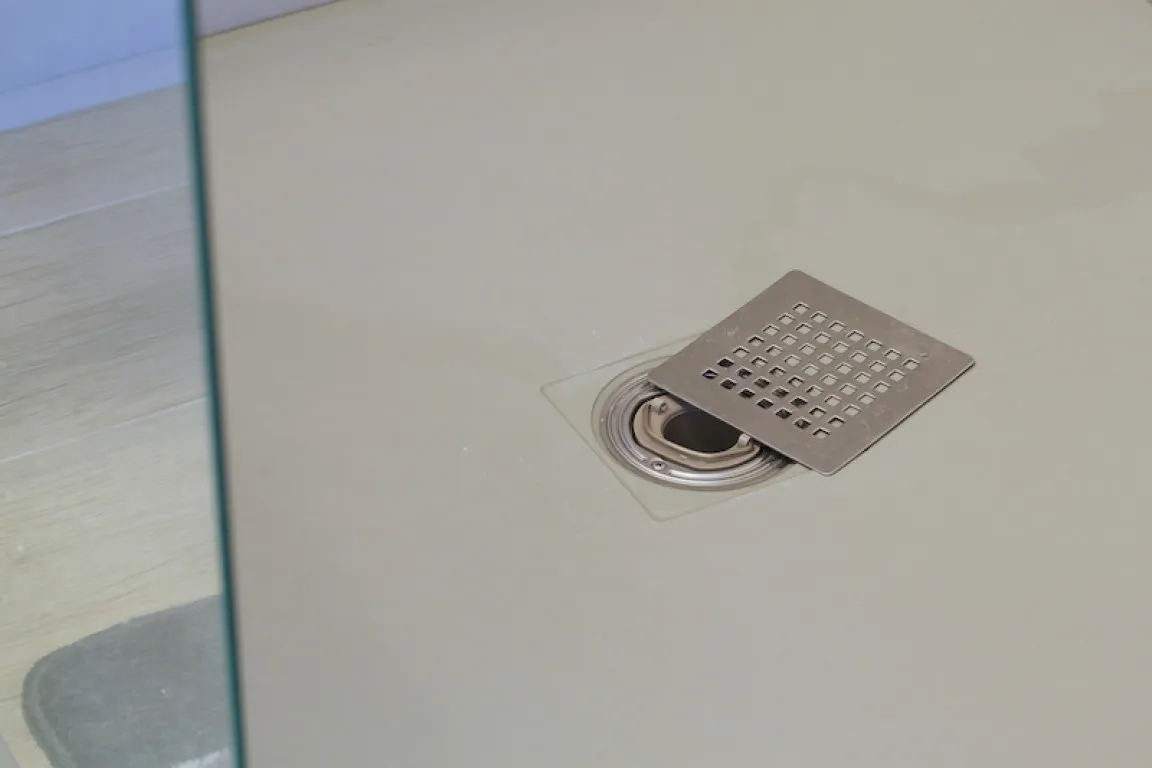A floor drain is not just a water drainage system, it also helps flow dirty water to maintain cleanliness and comfort in your bathroom. With various models available, such as plastic floor drains, square ones, baseboard designs, and even washing machine drains, you can choose one that fits your needs and matches your aesthetic bathroom’s design.
This article will discuss how to choose the right floor drain based on its design, area conditions, and maintenance requirements. From models like plastic floor drains, square shapes, to options for shower areas, you'll find a complete guide to ensure your bathroom remains odor-free and hygienic.
What Is a Floor Drain?
A floor drain is a filter installed on the floor to direct water flow. Thus, it is typically used in areas prone to water pooling, like bathrooms. Its main function is to prevent water buildup, which can cause problems such as unpleasant odors or insects.
This component is designed to make water flow smoothly while keeping debris out of the drainage system. With additional features like filters or traps, floor drains help maintain clean water channels, prevent pipe blockages, and minimize the risk of bad odors.
Why Is a Floor Drain Essential for a Bathroom?
A floor drain is essential for maintaining cleanliness and comfort in the bathroom. It helps direct water flow as well as filters out debris like hair and small trash that can cause blockages.
Some types of floor drains even feature water traps that prevent gas or odors from the drainage system from coming back into the bathroom. This way, your bathroom will remain fresh and comfortable.
Types of Floor Drain
Each type of floor drain has its advantages, depending on its function and where it is installed. Here are some of the most common types of floor drains you can find:
1. Plastic Floor Drain
Plastic floor drains are a popular choice as they are lightweight, easy to install, and affordable. They are also ideal for areas where high material durability isn’t essential, such as bathrooms with minimal water pooling.
2. Square Floor Drain
The square floor drain is one of the most commonly used models because it blends well with square or rectangular floor designs, especially in bathrooms. In addition, this model also provides a neater and more aesthetic look.
3. Shower Area Floor Drain
This type of floor drain is specially designed for use in shower areas, especially in hotels or sports facilities. As it is longer in shape, it can handle larger volumes of water while also filtering out hair or other small debris carried by the water.
4. Baseboard Floor Drain
The baseboard floor drain differs from other types because it is installed along the base of a wall or baseboard. This model is commonly used in outdoor areas or places prone to water pooling, such as yards or basements.
Washing Machine Floor Drain
This type of floor drain is typically installed in laundry areas or places where clothes are washed. It has a high absorption capacity to prevent water buildup due to leaks or excessive water flow. This floor drain is larger than those designed for bathrooms and often features a bigger filter.
How to Choose the Right Floor Drain
Here are some tips to help you select the perfect floor drain that suits both your bathroom needs and design preferences:
1. Consider the Installation Area
Before choosing a floor drain, it's important to assess the area where it will be installed. Is the area prone to water pooling or high humidity? For example, if you want to install it in your bathroom, you need to ensure that the floor drain you choose can handle a large volume of water.
Meanwhile, for laundry areas, you can select a floor drain that can trap debris like fabric fibers and ensure that the material is rust-resistant for long-term use.
Read also: Best Minimalist Roster Inspiration and Maintenance Tips
2. Check the Number of Faucets or Showers
The more water sources you have, the larger the floor drain should be to handle the flow. If you have multiple showers or faucets, then you need to make sure that the floor drain has the size and capacity to quickly channel water without causing pooling.
A floor drain with a larger diameter will help water flow faster and prevent pooling. On the other hand, a drain that's too small for the water volume can slow down drainage which will make the floor slippery.
3. Choose the Type Based on Your Needs
Floor drains come in different shapes, such as round or square, which creates different looks and also offer different functionality. For bathrooms, a rectangular drain is perfect for larger shower areas.
Floor drains with water traps are effective at preventing unpleasant odors, while decorative floor drains can enhance the bathroom’s aesthetics.
4. Match It with Your Bathroom’s Theme
If you want a floor drain that not only works well but also complements your bathroom's interior design, consider how it matches your floor and wall tiles to create a harmonious look that blends well with the overall room design.
For a modern minimalist bathroom, you can choose a simple stainless steel floor drain with a clean design. But, if your bathroom has a more classic theme, you may choose a floor drain with decorative details that support the theme.
Read also: 7 Minimalist Staircase Design Ideas, Aesthetic and Safe!
5. Floor Drain Filters Are Easy to Clean
Last but not least, you need to make sure the filter or cover of the floor drain can be easily removed so you can clean out accumulated debris, such as hair, soap, or other waste.
Some types of floor drains also feature a two-tier filtration system that helps clean debris more effectively. For instance, materials like stainless steel are also more durable and easier to maintain compared to plastic.
So, choosing the right floor drain is an important step in keeping your bathroom clean and comfortable. By considering various types, functions, and ease of maintenance, you can make sure your bathroom stays odor-free and always in top condition.
Semen Merah Putih Watershield, with its water-repellent technology and lotus leaf effect, provides extra protection against water seepage that can cause damage and mold. Additionally, this cement has excellent spreadability, making it the best choice for plastering, rendering, and brick laying.
If you're building or renovating your bathroom, make sure to use Semen Merah Putih Watershield for the best results. Contact us now for more information and discover the best construction solutions for your project!
Read also: 6 Industrial Bathroom Ideas and Tips for Decorating Them



